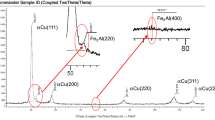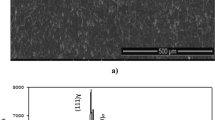Abstract
The single-phase CuAl8Fe3 aluminum bronzes possess good strength and resistance to fatigue as well as high corrosion and wear resistance. Since this alloy contains less than 8.5% aluminum, it cannot be heat treated. Therefore, improvements in surface integrity (SI) can only be achieved via mechanical surface treatment. This article investigates the influence of the basic diamond burnishing (DB) process, as well as additional factors, on the SI characteristics of CuAl8Fe3 bronze. Using experiments and regression analyses, a multi-objective optimization of the DB process has been accomplished via non-dominated sorting genetic algorithm (NSGA-II) and optimal values of the factors have been established. Using these factor values, the SI characteristics of diamond-burnished CuAl8Fe3 specimens have been quantified. The conclusion has been reached that the DB of CuAl8Fe3 bronze can be implemented as mixed burnishing, i.e., DB results in a favorable combination of the height and shape parameters for the surface texture, very low roughness (nearly mirror surfaces), large (in absolute value) residual hoop and axial stresses at depths greater than 0.8 mm, high surface micro-hardness and strongly expressed grain-refined microstructures at depths of up to 0.15 mm. These SI characteristics suggest a significant increase in fatigue strength and wear resistance of CuAl8Fe3 bronze finished via DB.














Similar content being viewed by others
Abbreviations
- α c :
-
Depth of cutting
- \(A_{5}\) :
-
Elongation
- \(c\) :
-
Axial spring constant (stiffness)
- \(d_{p}\) :
-
Depth of penetration
- \(E\) :
-
Young’s modulus
- \(f\) :
-
Feed rate
- \(F_{b}\) :
-
Burnishing force
- \(HV\) :
-
Vickers micro-hardness
- \(n\) :
-
Number of passes
- \(m\) :
-
Cyclic loading coefficient
- \(r\) :
-
Diamond insert radius
- \(R_{0,2}\) :
-
Yield limit
- \(R_{a}\) :
-
2D arithmetic mean deviation
- \(R_{a}^{init}\) :
-
Initial roughness
- \(R_{m}\) :
-
Ultimate stress
- \(S_{a}\) :
-
3D arithmetic mean deviation
- \(S_{ku}\) :
-
Kurtosis
- \(S_{p}\) :
-
Maximum peak height
- \(S_{q}\) :
-
Root-mean-square deviation
- \(S_{sk}\) :
-
Skewness
- \(S_{t}\) :
-
Total height
- \(S_{v}\) :
-
Maximum valley depth
- \(S_{z}\) :
-
Ten-point height
- \(v\) :
-
Burnishing velocity
- \(v_{c}\) :
-
Cutting velocity
- \(x_{i}\) :
-
Coded coordinate
- \(\tilde{x}_{i}\) :
-
Natural coordinate
- \(\Gamma_{x}\) :
-
Factor space
- \(\left\{ X \right\}\) :
-
Governing factors vector
- \(Y_{i}\) :
-
Objective function
- DB:
-
Diamond burnishing
- DR:
-
Deep rolling
- RB:
-
Roller burnishing
- SEM:
-
Scanning electron microscopy
- SI:
-
Surface integrity
References
ASM (1992) Handbook, Vol. 2, Properties and Selection: Nonferrous Alloys and Special-Purpose Materials, 10th ed. Am Soc Metals
El-Axir MH (2002) A method of modeling residual stress distribution in turning for different materials. Int J Mach Tools Manuf 42(9):1055–1063
Lopez de Lacalle LN, Rodriguez A, Lamikiz A, Celaya A, Alberdi R (2011) Five-axis machining and burnishing of complex parts for the improvement of surface roughness 26(8):997–1003
Catalogue E (2006) Tools and solutions for metal surface improvement. Ecoroll Corp Tool Technol Ohio
Maximov JT, Duncheva GV, Anchev AP, Dunchev VP (2020) Slide burnishing versus deep rolling – a comparative analysis. J Adv Manuf Technol 110:1923–1939
Korzynski M (2013) Slide diamond burnishing. In Nonconventional Finishing Technologies, Ed. M. Korzynski, Polish Scientific Publishers PWN, Warsaw
Hassan AM, Maqableh AM (2000) The effects of initial burnishing parameters on non-ferrous components. J Mater Process Technol 102:115–121
Bataineh O (2019) Effect of roller burnishing on the surface roughness and hardness of 6061–T6 aluminum alloy using ANOVA. Int J Mech Eng Robot Res 8(4):565–569
Kurkute V, Chavan ST (2018) Modeling and optimization of surface roughness and microhardness for roller burnishing process using response surface methodology for Aluminum 63400 alloy. Procedia Manuf 20:542–547
Revankar GD, Shetty R, Rao SS, Gaitonde VN (2014) Analysis of surface roughness and hardness in ball burnishing of titanium alloy. Measurement 58:256–268
Duncheva GV, Maximov JT, Dunchev VP, Anchev AP, Atanasov TP, Capek J (2020) Single toroidal roller burnishing of 2024–T3 Al alloy implemented as mixed burnishing process. Int J Adv Manuf Technol 111(11–12):3559–3570
Maximov JT, Duncheva GV, Anchev AP, Ichkova MD (2019) Slide burnishing – review and prospects. J Adv Manuf Technol 104:785–801
Sagbas A (2011) Analysis and optimization of surface roughness in the ball burnishing process using response surface methodology and desirabilty function. Adv Eng Softw 42:992–998
Maximov JT, Anchev AP, Duncheva GV, Ganev N, Selimov KF (2017) Influence of the process parameters on the surface roughness, micro-hardness, and residual stresses in slide burnishing of high-strength aluminum alloys. J Braz Soc Mech Sci Eng 39(8):3067–3078
Bednarski P, Bialo D, Brostow W, Czechowski K, Polowski W, Rusek P, Tobola D (2013) Improvement of tribological properties of matrix composites by means of slide burnishing. Mater Sci 19(4):367–372
Nestler A, Schubert A (2015) Effect of machining parameters on surface properties in slide diamond burnishing of aluminium matrix composites. Mater Today Proc 2S:S156–S161
He D, Wang B, Zhang J, liao S, Deng WJ, (2018) Investigation of interference effect on the burnishing process. Int J Adv Manuf Technol 95:1–10
Ugurlu M, Cinar CS, Buldum BB (2017) Improvement of surface roughness using ANOVA AZ31B magnesium alloy with ball burnishing process. Int J Eng Res Technol 6(9):216–221
Luo H, Liu J, Wang L, Zhong Q (2006) The effect of burnishing parameters on burnishing force and surface microhardness. Int J Adv Manuf Technol 28(7–8):707–713
Luo H, Liu J, Zhong Q (2005) Investigation of the burnishing process with PCD tool on non-ferrous metals. Int J Adv Manuf Technol 25(5–6):454–459
Shiou FJ, Banh QN (2016) Development of an innovative small ball-burnishing tool embedded with a load cell. Int J Adv Manuf Technol 87(1–4):31–41
ASME (2009) B46.1–2009, surface texture (surface roughness, waviness, and lay). Am Natl Stand
Vuchkov IN, Vuchkov II (2009) QStatLab professional, v. 5.5 – statistical quality control software. User’s Manual Sofia
Maximov JT, Duncheva GV, Anchev AP, Ganev N, Dunchev VP (2019) Effect of cyclic hardening on fatigue performance of slide burnishing components made of low-alloy medium carbon steel. Fatigue Fract Eng Mater Struct 42(6):1414–1425
Korzynski M (2007) Modeling and experimental validation of the force-surface roughness relation for smoothing burnishing with a spherical tool. Int J Mach Tools Manuf 47:1956–1964
Maximov JT, Duncheva GV, Anchev AP, Dunchev VP (2020) Smoothing, deep or mixed diamond burnishing of low-alloy steel components – optimization procedures. J Adv Manuf Technol 106:1917–1929
Deb K, Pratap A, Agarwal S, Meyarivan T (2002) A fast and elitist multiobjective genetic algorithm: NSGA-II. IEEE Trans Evol Comput 6(2):182–197
Zhang J, Pei ZJ (2010) Characterization methods for surface integrity (Ed., J. Paulo), surface integrity in mashining. Springer – Verlag London Limited e-ISBN 978–1–84–882–974–2
Sedlacek M, Podgornik B, Vizintin J (2012) Correlation between standard roughness parameters skewness and kurtosis and tribological behaviour of contact surface. Tribol Int 48:102–112
Acknowledgements
This work was supported by the European Regional Development Fund within the OP “Science and Education for Smart Growth 2014-2020,” Project CoC “Smart Mechatronics, Eco- and Energy Saving Systems and Technologies,” №BG05M2OP001-1.002-0023.
Funding
This work was supported by the European Regional Development Fund within the OP “Science and Education for Smart Growth 2014–2020,” Project CoC “Smart Mechatronics, Eco- and Energy Saving Systems and Technologies,” №BG05M2OP001-1.002–0023.
Author information
Authors and Affiliations
Contributions
Conceptualization—GD and JM; Methodology—GD and JM; Software—GD and JM; Experiment—AA, VD, YA, NG, DD; Data analysis—JM, GD and YA; Writing (original draft preparation) —JM and GD; Writing (review and editing) —JM and GD; Visualization—GD, JM and AA; Supervision—JM and GD.
Corresponding author
Ethics declarations
Ethics approval
All authors have read and agreed to the current version of the manuscript.
Consent to participate
All authors have declared consent to participate.
Consent for publication
All authors have declared consent to publish the research results.
Additional declarations for articles in life science journals that report the results of studies involving humans and/or animals
Not applicable.
Conflicts of interest/competing interests
The authors declare no conflict of interest.
Additional information
Publisher's note
Springer Nature remains neutral with regard to jurisdictional claims in published maps and institutional affiliations.
Rights and permissions
About this article
Cite this article
Duncheva, G.V., Maximov, J.T., Anchev, A.P. et al. Improvement in surface integrity of CuAl8Fe3 bronze via diamond burnishing. Int J Adv Manuf Technol 119, 5885–5902 (2022). https://doi.org/10.1007/s00170-022-08664-9
Received:
Accepted:
Published:
Issue Date:
DOI: https://doi.org/10.1007/s00170-022-08664-9




